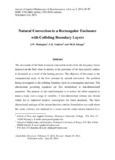| dc.contributor.author | Mutuguta, John W. | |
| dc.date.accessioned | 2017-03-23T07:26:58Z | |
| dc.date.available | 2017-03-23T07:26:58Z | |
| dc.date.issued | 2014 | |
| dc.identifier.uri | http://hdl.handle.net/123456789/1387 | |
| dc.identifier.uri | http://www.scienpress.com/Upload/JAMB/Vol%204_2_5.pdf | |
| dc.description.abstract | The movement of the fluid in natural convection results from the buoyancy forces imposed on the fluid when its density in the proximity of the heat transfer surface is decreased as a result of the heating process. The objective of this paper is the computational study of the flow initiated by natural convection. The problem being investigated is the colliding boundary layer in a rectangular enclosure. The dimensional governing equations are first transformed to non-dimensional equations. The purpose of this transformation is to reduce the effort required to make a study over a range of variables. A non-dimensional scheme was chosen which led to improved iterative convergence for faster transients. The three dimensional analogue of the stream function-vorticity formulation was used where the scalar vorticity was replaced by a vector and the scalar stream function by a86 Natural Convection in a Rectangular Enclosure with Colliding Boundary Layers
vector potential. The equations were then solved using the method of variable false transients. The results indicated that the flow region is stratified into three regions; a cold upper region, a hot region in the area of the confluence of hot and cold streams and a warm lower region. | en_US |
| dc.language.iso | en | en_US |
| dc.publisher | Journal of Applied Mathematics & Bioinformatics | en_US |
| dc.subject | Colliding boundary layer | en_US |
| dc.title | Natural Convection in a Rectangular Enclosure with Colliding Boundary Layers | en_US |
| dc.type | Article | en_US |

